BY ROB FELD
 COMIC TIMING: Lawrence Kasdan says there
COMIC TIMING: Lawrence Kasdan says there
have been great comedies but nothing
like Dr. Strangelove. (Credit: Wilson Webb)
I don't remember the first time I watched Dr. Strangelove and felt it was the funniest movie I'd ever seen," says Lawrence Kasdan, in his living room feet up, screen down, and ready to watch it once more, but it was probably seeing it again at the University of Michigan. "I doubt that I was open enough to it when I was 14, but when I saw it again I flipped out. I was thinking about being a director and writer, so it had an enormous impact on me."
Dr. Strangelove or: How I Learned to Stop Worrying and Love the Bomb (1964), Stanley Kubrick's quintessential sendup of the Cold War era, opens with stock footage of bombers refueling in midair in an aeronautically mock-erotic credit sequence. As Kasdan points out, the intricately structured film follows interwoven action in just four locations: an Air Force base and its environs, the War Room at the Pentagon, and inside a B-52 bomber. Kubrick juggles these pieces of America's political and war machines as they move inevitably toward nuclear war with the Soviet Union.
"This movie is the most incredible mix of styles and tones, things you would never think you could mix, and it totally works as one piece," marvels Kasdan, relishing the opportunity to revisit one of his favorite films. "You start with a very stylized setup shot of mountains through the clouds, then immediately you're into stock military footage of bombers being refueled during the titles. And the stock footage will be echoed throughout the movie by newsreel-like, vérité coverage of the attack on the Air Force base. There's nothing more beautiful than the black and white film, and the newsreel feeling adds to the reality enormously."
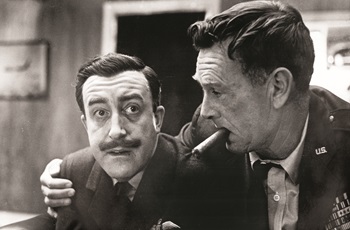 Peter Sellers (left), in one of his three roles, is overpowered by Sterling Hayden's
Peter Sellers (left), in one of his three roles, is overpowered by Sterling Hayden's
Gen. Jack Ripper. "It's Sellers' understatement that's so funny." (Credit: Photofest)
Kubrick wastes no time getting his narrative going as we see a mild-mannered British liaison, Group Capt. Lionel Mandrake (Peter Sellers, in the first of three incarnations), cleverly invisible behind a drapery of computer paper at the Air Force base. "Look at this brilliant introduction of Sellers," Kasdan says, as Mandrake steps out from behind the paper to answer a call from Brig. Gen. Jack Ripper (Sterling Hayden). From his darkened office, Ripper orders Mandrake to initiate Wing Attack Plan R—a nuclear air attack on Russia. "It throws you right in," says Kasdan.
"Oh, hell," is Sellers' pitch perfect, oh so British, response to the unthinkable. Kasdan focuses immediately on the performance and design elements Kubrick uses to build the tension to great comic effect. "Sellers and Hayden are both playing in a very quiet mode," Kasdan observes. "Ripper is in his cave, which he will never leave through the entire movie; that's where he'll lure and trap Mandrake. He's in a place where shadows have taken over, sitting under this very directional fluorescent light. In his own mind, he's speaking perfectly rationally. Mandrake, on the other hand, is in a brightly lit environment where computers reign, things are rational. It's Sellers' understatement that's so funny, the way he deals with this irrational voice from the dark."
The next thing that catches Kasdan's eye is Ken Adam's linearly designed set for Ripper's office. "It's a very horizontal composition," Kasdan says, demonstrating with his hands. "A third of the screen is that horrible ceiling you find in any Air Force base, then the fluorescent light bouncing off the ceiling, and bouncing down onto Ripper. He seems completely isolated, alone, nuts, like an old medieval king on his throne."
It's barely six minutes into the film and already Ripper is sitting at his desk with the threat of nuclear annihilation firmly established. Kubrick then cuts away from this stylized scene back to the aerial stock footage and model shots where Major "King" Kong (Slim Pickens) is in a claustrophobic B-52—a set so accurate it reportedly alarmed the U.S. government.
"Everything in here has a different style than the office," Kasdan observes, as Kubrick creates a separate and distinct sense of realism for the interior of the plane where the crew receives its coded marching orders. "It's all handheld, very much within the constraints of this tiny space," Kasdan notes. "And there are all these tight little zooms into the instrument board that I love, one after another. Also the details of all this code stuff: the way the crew deals with the dashboard, unlocking the safe, taking the envelope, and the directions for each crew member. The sense of verisimilitude Kubrick gives is so great, which is what makes the whole comedy work in its absurdity."
As the message to attack is confirmed, Kong takes out his cowboy hat from the safe, the finishing touch on his character. Knowing every beat by heart, Kasdan chuckles when the fife and drums of "When Johnny Comes Marching Home" starts playing on the soundtrack. "This is the B-52 music," Kasdan says, watching Kong launch into an exhortation of his crew as they brace for a mission for which they've spent their lives training.
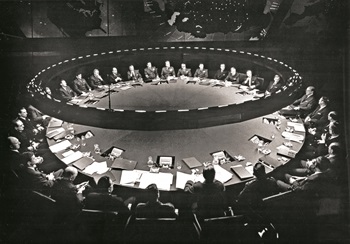 SETTING THE TABLE: A completely enclosed circle of men sitting in the War
SETTING THE TABLE: A completely enclosed circle of men sitting in the War
Room controls the fate of the world. "A major motif of the War Room is those
curves. The wall is like a Cinerama screen behind them." (Credit: Photofest)
Kasdan points out how the look of the location complements the content of what Kubrick is trying to say. "The navigator is practically cadaverous, the way he's looking up and the lights fl are. It makes it seem real, like this isn't a Hollywood picture where everything is controlled. Kubrick lets the lights flare because it's like a newsreel; you have no control in a confined space like that. It adds to the claustrophobia of the jet. Kubrick is constantly playing with the contrast between the seriousness here and the absurdity elsewhere."
The next location is Gen. "Buck" Turgidson's (George C. Scott) love nest, where the bikinied body of his secretary (Tracy Reed) lays under a sunlamp. "This scene sets up the whole movie," Kasdan says as Kubrick keeps the camera on Reed answering the phone and relaying messages from a colonel about the attack under way. Turgidson is off screen in the bathroom and depending to whom she is speaking, Reed's body language changes, playing to each man.
"Strangelove is what I would call 'a comedy of forbearance,' " Kasdan explains. "Kubrick never moves the camera if he doesn't have to; the tension simply increases by sitting still. This whole scene is without a cut. We have not yet seen Turgidson, but we can imagine he's sitting on the toilet in the other room, and the tension just builds. And then there's Reed's sexual byplay—watch how she shifts her body; she's fucking the other guy too! So there are all these levels happening.
"The audience is used to the director cutting around," Kasdan continues, "to show them what they're hearing, but Kubrick denies you that all the time. The entire movie displays the same forbearance; that's what Sellers' quiet performances are all about as Mandrake and the president. They could do something large but instead everything is just absorbed. We just see the wheels turning in their heads. And that takes enormous discipline on a director's part, to trust that nothing has to be too over the top or demonstrated for an audience."
The action shifts back to the base where Ripper locks Mandrake in his office to prevent him from recalling the attack, the reality of Ripper's insanity becoming more obvious. The key here, says Kasdan, is Kubrick's tremendous confidence as a director, shooting the extended exchange on Ripper's back, allowing the audience to watch Sellers' restrained anxiety increase.
"It's terribly important how long Kubrick sits on Ripper's back. This, again, is total control. Sellers gets to play the entire cave; he goes all the way to the far wall, back to the front of Ripper's desk, hiding his growing hysteria. Ripper is positioned to the right of the camera, practically silhouetted by the fluorescents, and Mandrake gets to play the entire stage. Another director would have had him running around the room, desperately trying all the doors."
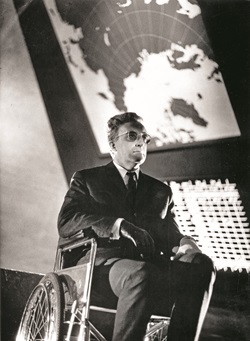 WE'LL MEET AGAIN: Dr. Strangelove (Sellers) is
WE'LL MEET AGAIN: Dr. Strangelove (Sellers) is
introduced in full light cast by the table.
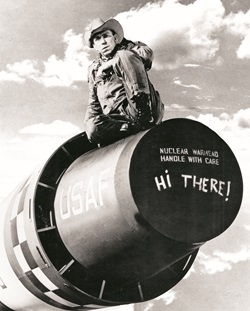
Slim Pickens in "one of the three or four most famous
images in American movies." (Credits: Photofest)
Kasdan pauses for a moment, reflecting on the influence of Strangelove on his own work. "I learned to trust the shot from this movie—staying with it can build enormous comic tension—especially when you're working with great actors. Just like great athletes, they'll astound, delight, and take your breath away. When you have someone like Sellers playing hysteria but under control, it's very, very funny. It's the same kind of forbearance."
Getting back to the business at hand, Kasdan continues. "When Kubrick finally cuts to this Rushmore-like shot of Ripper, up through his cigar, Mandrake knows that this guy is completely berserk. Hayden doesn't have to do much because his eyebrows and deep-set eyes do a lot of it, but Kubrick put great highlights in his eyes, and that's not by accident at all. His face is almost skeletal, there are dark holes where his eyes are, and then these pinpricks of light. Ripper has his own insane genius about what's happening in the world."
Next, the location shifts to the War Room and Kasdan is immediately drawn in by the beautiful introductory shot. "It's interesting because the shot of the Pentagon is standard establishing shot stuff," he says. "Then you cut inside and the lower half of the screen is all the men enclosed by an oval of light, and the top half of the screen is a panoramic-like view of the world. This circle of men, completely enclosed, is going to control the destiny of the entire world, which is pictured above them. When people wander out of [the circle] toward the sides they get a smoky look from the spotlights pointing in, which makes no sense but creates this lovely, crazy, spooky environment, cut off completely from the world. It's all done with a very wide-angle lens."
In the War Room the camera holds steady on its subjects, unlike in the plane or the vérité footage at the air base, which had Kubrick "dirtying" every frame with protruding branches and leaves. "Straight out of D-Day newsreels," says Kasdan.
"But in the War Room," Kasdan contrasts, "you're shooting up at Scott most of the time in close-up. Then when he starts to give his long speech in the foreground about Plan R, all those guys around the table are arranged perfectly—everything is perfectly composed and there's not a move in it, no dolly."
Kasdan laughs at the interplay between Scott, directed by Kubrick to ham it up, and Sellers, now as President Merkin Muffley, responding to him with subtle absorption. "Look at that," Kasdan marvels. "Sellers doesn't even move his head. All eyes. You could put that performance in a regular thriller."
And the design perfectly complements Kubrick's staging. "He lets the big curve of the light above be a huge design element. A major motif of the War Room are these curves. The wall is like a Cinerama screen behind them, curving around when we're in those big wide shots. Kubrick is playing with the perspective in this case, with Scott's foreground dominance of everything."
When the Russian ambassador is summoned to the War Room, he reveals the existence of the Doomsday Machine, which will automatically explode and destroy life on Earth should the bomber succeed. Here, Kasdan eagerly anticipates the entrance of Sellers in his third role, Dr. Strangelove himself, to explicate the logic of the Doomsday Machine.
"First he's announced before he's seen, like any good theatrical move," Kasdan explains. "Then you get his full profile in full light cast from the table, and as you drop back between the president and ambassador, you see this gorgeous composition—again, the circular light bisecting the frame, hovering in the middle like a UFO.
"In the close shot," Kasdan continues, "Strangelove pushes out from way down by the table and wheels himself up to talk to the president and ambassador, and they're practically silhouetted on each side, framing him. It's an amazing entrance."
Kasdan stops for a moment, but there is really no time for him to catch his breath. "Kubrick's cutting between the three stories gives the film enormous positive momentum," he says. "Every time you think you're stuck in one story, you cut to another but then are desperate to get back."
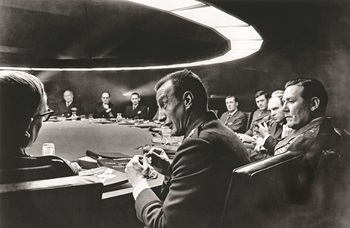 George C. Scott as Gen. "Buck" Turgidson was the one character
George C. Scott as Gen. "Buck" Turgidson was the one character
directed to ham it up. (Credit: Photofest)
The action now shifts to a missile tracking the B-52 and back into the cockpit where the crew still is trying to deliver its payload, which will unwittingly set off the Doomsday Machine.
"Kubrick does it all on the radar scope, enormous tension trying to avoid the missile as it gets closer. It's really action-movie-on-the- cheap, and it totally works. The chaos and noise is so great that it's completely convincing, but you could do this shot in your basement. It's all handheld, very quick cutting, fl are, a little flame, up tight in their faces, and the focus comes and goes just like in real newsreel photography. Kubrick pushes in through the smoke and Slim Pickens is silhouetted against it in his cowboy hat, which is one of the film's great shots. It encapsulates the whole movie because you've got this cowboy in the center of this death machine, everything is going to hell, all communication has been lost with rationality or headquarters, and they're going to be lone cowboys, pulling off this mission. You could say, 'Is this a comedy?' But that's what's so funny; everything is played straight and it's as good an action movie as it could be during this sequence. Then when the comedy comes, the absurdity of the situation is five times more powerful."
And then the inevitable conclusion to all the madness, what Kasdan calls "one of the three or four most famous images in American movies." Slim Pickens sitting astride a bomb, whooping it up, riding it through the sky like a bucking bronco.
"It was amazing how Kubrick steered this film," Kasdan concludes, as Pickens rides the bomb to oblivion, audaciously accompanied by Vera Lynn singing "We'll Meet Again." "Everybody who's ever made movies has that image burned into his brain. It's not even a particularly great effects shot, but it's the greatest possible idea, and that's always more important than the shot itself. There are so many land mines in this kind of movie, with this many tones and variety of jokes. That's why it's never been done again. There've been great comedies but I just can't think of what's on the list with this."